Belgian filmmaker Olivier Vandersleyen’s new documentary comes out this November after three years in production. The film is a detective-like investigation into one chapter of the Exodus: the Ten Plagues of Egypt and what triggered them. “It’s not fiction with fake situations, fake Egyptians and fake scribes, telling a story invented from scratch,” he says in an interview. “I interviewed experts and cross-checked the information across several scientific domains.”
The story starts with a cataclysmic eruption in the Mediterranean Sea 3,500 years ago. Some researchers have recently connected this to a mysterious Egyptian stela, or inscribed stone slab, that none other than Vandersleyen’s father first translated exactly fifty years ago.
Now 90, Claude Vandersleyen is a Belgian Egyptologist. In 1957, based on a photograph, he deciphered a stela discovered in 1945 in Karnak (now Luxor, Egypt). From then on, the stela, signed by the Pharaoh Amosis, was called “The Tempest Stela” because it describes the consequences of a huge storm, which hit Egypt. In addition, two of Egypt’s famous ten plagues are mentioned.
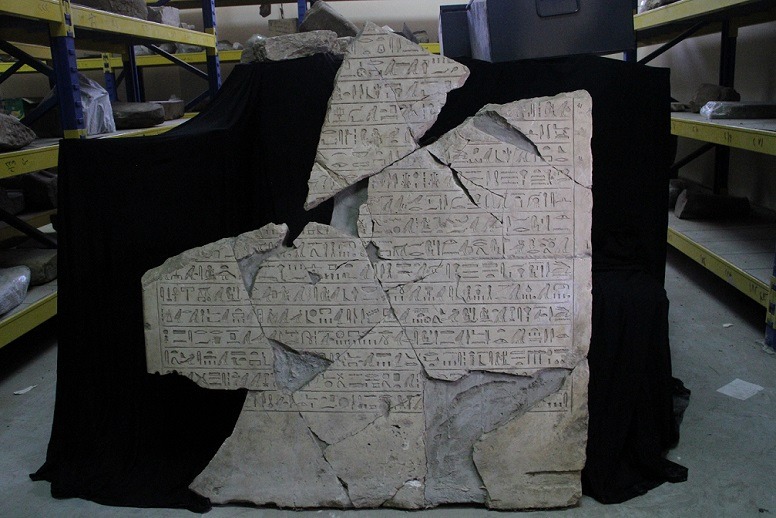
The Tempest Stela, found in the third pylon (gateway) of the temple of Karnak at Thebe (now Luxor, Egypt)
Claude’s son, Olivier Vandersleyen, is not an Egyptologist. Olivier’s three previous documentaries depicted a Belgian industrial past with the faces and voices of those who lived it: grapes from greenhouses (2010), ‘marbrite’ glass (2014) and hats (2015). Here, he is far away from an industrial heritage, but “it was too tempting, with my father’s mind still intact and the whole story waiting to be told.”
Cataclysmic eruption
Egyptologist Claude Vandersleyen has always argued that the Exodus started during the reign of Amosis or shortly after. But this doesn’t give it a date. The problem with the 3,000-year long epoch of Ancient Egypt is that Egyptologists have more or less established the succession and duration of the Pharaohs’ reigns, but without precise dates.
The Bible gives a date for the Exodus, though: around 1450 BC. An expert in the film puts it at 1300 BC, on the grounds that “no proto-Israelites have been found before [that date]”. Claude Vandersleyen leaned more towards 1550-1524 BC, based on the Story of Egypt (Ægyptiaca) written by Manetho, an Egyptian priest, in the 3rd century BC. Manetho explicitly states that Moses lived during the reign of Amosis.
“I started with the idea that the Exodus happened,” Olivier Vandersleyen recounts. In 2014, entirely by chance, he came across an article from two researchers at the University of Chicago who connected his father’s stela to the eruption of a volcano. It blew up half of the - now Greek - island of Santorini 3,500 years ago. The plagues of Egypt could have been a consequence of this eruption, which was felt in the whole southeast Mediterranean and Levant. By dating the eruption, Olivier Vandersleyen reasoned, it would be possible to date the Exodus.
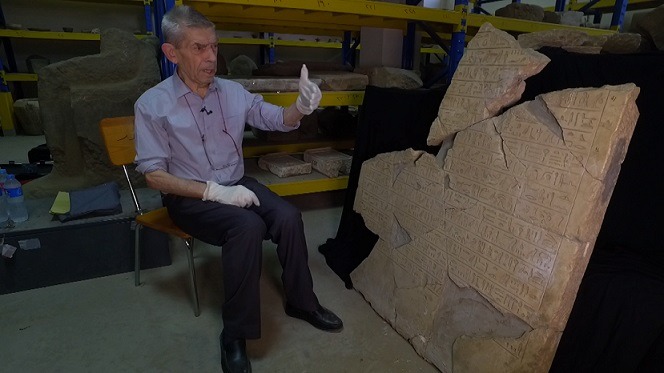
Claude Vandersleyen translating the hieroglyphs of the Tempest Stela, fifty years after his original translation based on a picture
The filmmaker went to see the experts and got what he wanted: his film connects all the dots to come up with a date for the eruption of the Santorini volcano, “the biggest on earth since ancient times”. It turned out to be even bigger than previously thought, from scientific discoveries during the three years of shooting. Dendrochronologists (scientists who read tree rings), archaeologists, astronomers, climatologists and geologists made it possible to converge on a date of the eruption (and hence Amosis’ reign): 1628 BC.
That’s two hundred years earlier than estimates before the film. “In the last hundred years, the historical timeline for Ancient Egypt has shifted by 2,000 years,” Olivier Vandersleyen notes. His film is the latest contribution to making the historical timeline more accurate. As well as filming the stela for the first time, he uniquely brings together data from a papyrus, which describes the catastrophes that befell Egypt after the eruption of Santorini, and Babylonian clay tablets, which state that Venus could not be observed because of the dust in the sky after the eruption.
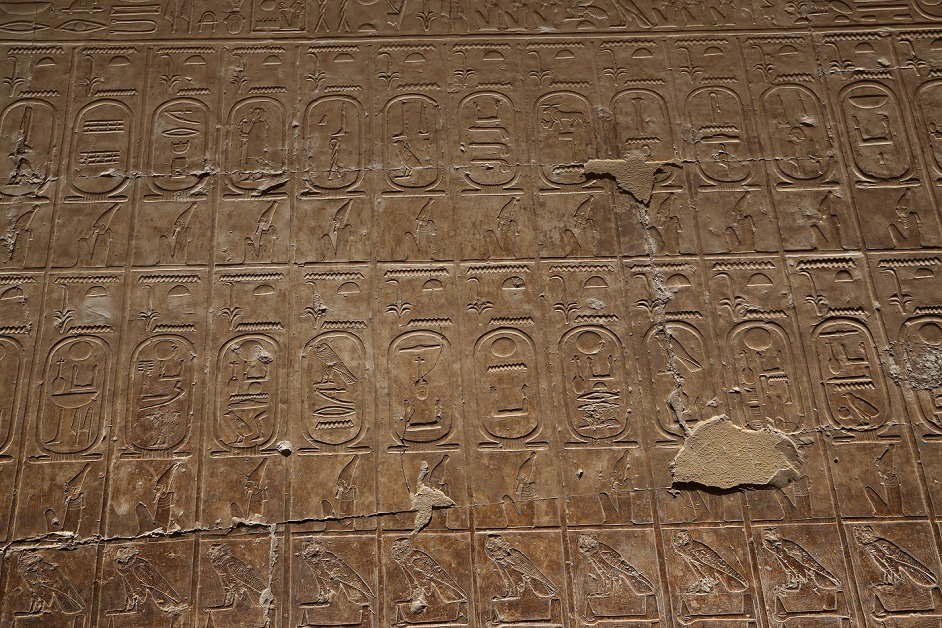
The ‘Abydos Table’: a list of the 70 kings of Ancient Egypt engraved on the wall of the Temple of Seti I at Abydos (Egypt)
The eruption was so strong that it destroyed 90% of the ozone layer and left the sky dark for at least six months, climatologists suggest in the film. A cold wave hit Egypt; its agriculture never recovered. This could have led to an exodus, not only of Hebrews but of all populations in the Nile Delta. “It’s the same story as with immigrants today,” explains Olivier Vandersleyen. “You are scared or you are hungry, so you move.”
Tour de force
Somewhere along the way, the filmmaker reached a tipping point. “I met with the best experts in the world on this subject,” Olivier Vandersleyen says. “Climatologists, archaeologists, volcanologists, you name it.” But “the more I progressed in my research, the more I moved away from the Exodus. The film was going nowhere. I was stuck.”
He experienced a six-month dip and thought of abandoning the project, when he realised that his credibility was under threat: “I don’t create stories. My reputation is one of solid proof, and my religion is to remain credible and honest.” He never inserts fiction into his movies: “I shoot what I see, nobody acts for me.” This requires a real tour de force for a film that explores events, which occurred 3,500 years ago.
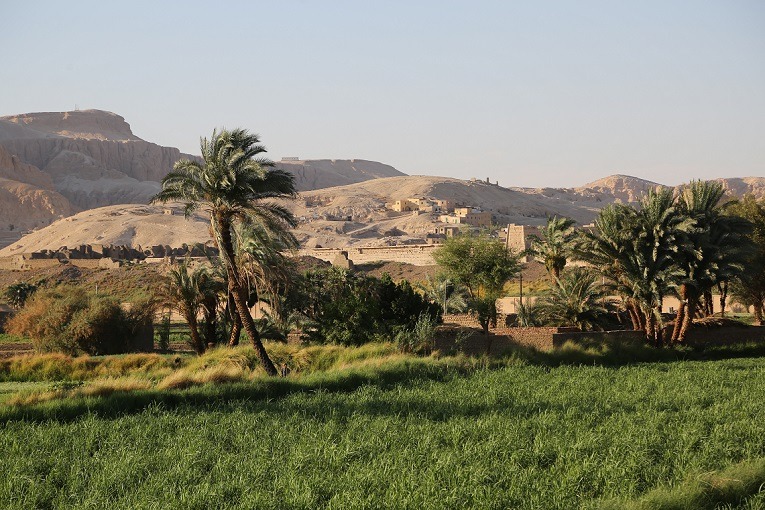
The West Bank of the Nile at Luxor (Egypt)
And then one day, Olivier Vandersleyen turned his film upside down: he had arrived at a non-event (the Exodus) and henceforth decided that this should be the outcome of the film. From that moment on, he followed a new rationale: theology could explain how and why the writers of the Bible were influenced. He went on a fresh hunt for experts.
First stop, Liverpool, where Vandersleyen met Egyptologist Roland Enmarch, the world’s top specialist on the so-called Ipuwer Papyrus, which describes in its lament a series of terrible events in Egypt. Written in the 13th century BC, it clearly inspired the Bible concerning the Ten Plagues in the Book of Exodus. “A lot of catastrophes litter Egypt’s history,” explains Olivier Vandersleyen. “But they derive from the whole of Egyptian literature. These catastrophes have never existed in the specific framework of the story of Moses and his descendants.”
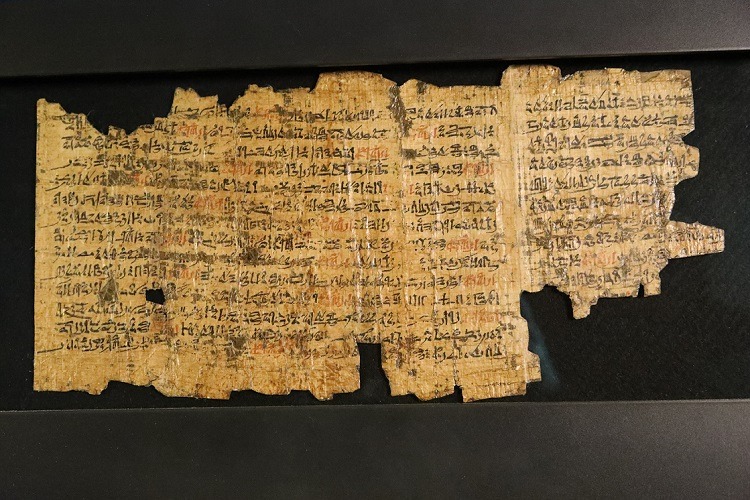
The ‘Ipuwer Papyrus’ contains the ‘Admonitions of Ipuwer’, a poem describing chaos and disarray in Egypt around 1250 BC (Dutch National Museum of Antiquities in Leiden, The Netherlands)
He continues: “Less than a century ago, everybody thought that The Bible was The Truth. People believed in its historicity. On the ground, they undertook ‘biblical archaeology’. But nobody has found any trace in the Sinai desert of hundreds of thousands of Hebrews fleeing from Egypt. Instead, today, a new generation of archaeologists is disassociating themselves from the Bible.” He concludes: “My movie puts the record straight: the Exodus is not a historical word for word event but a legend. The problem with lots of films and documentaries is that they seek to prove that the Bible tells the truth.”
Founding myth
Professor Israel Finkelstein, a well-known archaeologist from the University of Tel Aviv and author of The Bible Unearthed where he challenged our perception and understanding of the Bible, says: “The Exodus is one of the more complicated parts of the Bible to verify historically […] I don’t think there is evidence in Egypt for the event of Exodus as such, as an event […].” It’s not even really a topic for modern scholars, unless there is a very specific reference to it, he adds.
Finkelstein questions the traditional chronology in archaeological-biblical research, especially the transition from the Bronze Age to the Iron Age during the centuries before the establishment of the first Jewish kingdom in the 10th century B.C. in the country. The absence of archaeological evidence for specific events or persons mentioned in the Bible indicates in his view that it has been written centuries later and reflects an ideology of its time rather than what actually happened.

The ‘Book of Exodus’ is the second book of the Old Testament, the first part of the Bible
That said, archaeological findings do continously shed light on the Biblical narrative and show that it must have been based on earlier written sources or oral traditions. A good new example of this is the excavations in the valley of Elah southwest of Jerusalem, where a fortified city with casemate walls and two gates dating back to the 10th century B.C. and the time of King David were discovered.
The Bible mentions a city called Sha´arayim, i.e. city with two gates, as were discovered in the excavations besides a number of fascinating artifacts. According to the archaeologists who have been excavating the site since 2007, only a strong centralized power could have built a fortress city like this at such a strategic place.
The absence of archaeological evidence does not necessarily mean that we stop believing. “The value is in the message that you have in the text,” says Finkelstein. A legend can remain strong despite that there is no scientific evidence to prove it. In Olivier Vandersleyen’s film, a theologian from the Sorbonne, Thomas Römer, explains that it can help a group to find its identity and pass on something to the next generation.
The exodus from Egypt is mentioned several times in the Bible and always as a reminder not to discriminate foreigners and migrants but to treat them fairly. Legend or truth, the story about the liberation from slavery in Egypt has not only formed the identity of the Jewish people and its memory, still celebrated in the Passover holiday, but also inspired other peoples in their struggle against oppression and for freedom.
“The Exodus is certainly a founding myth, a founding story, like all peoples have,” Olivier Vandersleyen agrees. His quest to find out what happened in Ancient Egypt 3,500 years ago, complete with witnesses, clues and a squad of scientific experts, is a hard-won detective story that draws you in and sheds new light on the Bible’s Book of Exodus.
The Tempest Stela – revisiting the roots of the Exodus, 65 mins, 1st public screening at Le Phare (Uccle) on 17th of November 2017 and on sale in DVD at widescreen.be
By Hughes Belin

